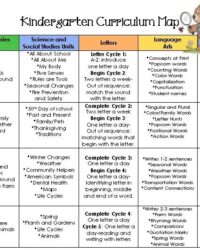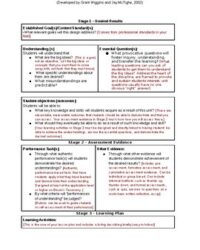Have you ever found yourself planning a lesson, getting excited about an activity, only to realize halfway through that it doesn’t quite align with what you intended students to learn? It’s a common experience for educators, but there’s a powerful antidote to this common planning predicament: backwards planning. This pedagogical approach flips the traditional planning model on its head, encouraging you to start with the desired learning outcomes and work your way backward to design effective instruction and assessment. It’s about clarity, intentionality, and ensuring every single minute in the classroom serves a clear purpose.
The beauty of backwards planning lies in its logical flow and student-centered focus. By first envisioning what students should know, understand, and be able to do at the end of a unit or lesson, you can then thoughtfully design the assessments that will demonstrate that learning. Only after these two crucial steps are in place do you move on to crafting the learning experiences. This structured thinking ensures that activities are purposeful, assessments are authentic, and the overall learning journey is coherent and effective. If you’re looking to streamline your lesson design and maximize student learning, understanding and utilizing a solid backwards planning lesson plan template is a game-changer.
Why Backwards Planning Just Makes Sense for Educators
At its heart, backwards planning, also known as Understanding by Design (UbD), asks educators to begin with the end in mind. Instead of starting with textbooks or fun activities, you begin by defining the clear learning goals. What big ideas do you want your students to grasp? What essential questions should they be able to answer? What skills should they master? This initial clarity acts as a compass, guiding every subsequent decision in your planning process. It prevents the common pitfall of "activity-first" teaching where engaging tasks might fill time but lack a strong connection to learning objectives.
The benefits of this approach are manifold. Firstly, it brings immense clarity to both the teacher and the students. Everyone knows what the destination is, making the journey more focused and purposeful. Secondly, it naturally leads to more effective and authentic assessments. When you know exactly what understanding or skill you want to measure, designing an assessment that truly reflects that becomes much simpler and more accurate. Finally, and perhaps most importantly, backwards planning encourages student-centered learning. By focusing on what students need to achieve, you inherently design experiences that cater to their learning needs and help them actively construct knowledge.
Consider the traditional planning method, which often starts with curriculum topics and moves straight to activities. While this can lead to engaging lessons, it sometimes results in a disconnect between activities and actual learning outcomes. Backwards planning forces a different mindset, prioritizing the "why" before the "what" and "how." It ensures that every activity, every resource, and every teaching strategy directly contributes to students achieving the defined learning goals, making classroom time incredibly efficient and impactful.
Utilizing a structured backwards planning lesson plan template can significantly enhance this process. It provides a framework that prompts you to consider all critical elements systematically, ensuring no crucial step is missed. It acts as a cognitive guide, leading you through the stages from desired results to evidence of learning, and finally to the learning plan itself.
The core stages of backwards planning are generally outlined as follows:
- Stage 1: Identify Desired Results: What should students know, understand, and be able to do? What are the enduring understandings and essential questions?
- Stage 2: Determine Acceptable Evidence: How will you know if students have achieved the desired results? What performance tasks, quizzes, or observations will serve as evidence?
- Stage 3: Plan Learning Experiences and Instruction: What knowledge and skills will students need to achieve the desired results? What learning activities and teaching strategies will best facilitate this?
This systematic progression ensures that your instruction is purposefully aligned with your goals, creating a more cohesive and impactful learning experience for everyone involved.
Crafting Your Own Effective Backwards Planning Lesson Plan Template
While many ready-made templates exist, understanding the core components allows you to either choose the best fit or even design your own backwards planning lesson plan template that perfectly suits your teaching style and subject matter. The key is to ensure it captures all three stages of the UbD framework: desired results, evidence, and learning plan. A good template acts as your personal coach, prompting you to think deeply about each stage before moving on.
When designing or selecting a template, think about what information you consistently need to capture for effective planning. It should be comprehensive enough to cover all necessary elements but not so overwhelming that it becomes a burden. Remember, the goal is to streamline, not complicate. A well-designed template encourages thoughtful reflection and ensures alignment across objectives, assessments, and activities.
Here are some essential components you’ll typically find in an effective backwards planning lesson plan template:
- Unit/Lesson Title & Subject: Basic identification.
- Grade Level & Duration: Practical details for context.
- Stage 1: Desired Results
- Established Goals/Standards: List the specific curriculum standards or learning objectives.
- Understandings: What big ideas should students understand?
- Essential Questions: Thought-provoking questions that guide inquiry.
- Students Will Be Able To (SWBAT): Specific, measurable learning outcomes.
- Stage 2: Acceptable Evidence
- Performance Tasks: Authentic, real-world application tasks.
- Other Evidence (Quizzes, Observations, etc.): Formative and summative assessments.
- Rubrics/Criteria for Success: How will student learning be evaluated?
- Stage 3: Learning Plan
- Learning Activities: What sequence of activities will help students achieve the desired results?
- Key Learning Events: Major lessons or experiences.
- Differentiation: How will you address diverse learning needs?
- Resources: Materials, technology, and readings required.
Implementing backwards planning, especially with the aid of a well-structured template, transforms the way you approach lesson design. It shifts the focus from simply covering content to ensuring deep understanding and measurable learning. This intentionality not only benefits students by making their learning journey clearer and more meaningful but also empowers educators with a robust framework for effective instruction.
Embracing this methodical approach to lesson planning ultimately leads to more cohesive units, more accurate assessments, and, most importantly, more profound and lasting learning for your students. It’s an investment in thoughtful pedagogy that pays dividends in the form of confident, capable learners ready to tackle the challenges ahead.


